|
F6F-3
ProfiPACK
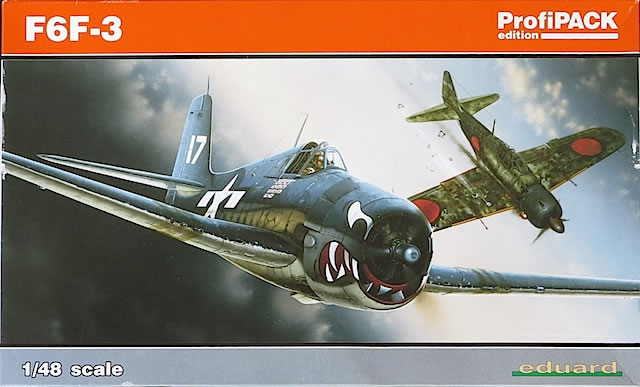
Eduard, 1/48 scale
S u m m a r y : |
Catalogue Number: |
Eduard Kit No.8221 – F6F-3 ProfiPACK |
Scale: |
1/48 |
Contents & Media: |
Approximately 108 grey plastic parts (1 unused); 17 clear plastic parts (2 unused); 4 grey resin parts; 1 decal sheet containing markings for 5 aircraft and stencils for 1 aircraft; 2 sheets of photo-etched brass (1 pre-painted and 1 unpainted); 1 sheet of pre-cut canopy masks; 16 page A4 full colour instruction booklet. |
Price: |
USD$29.71 plus shipping available online from Eduard’s website and specialist hobby retailers worldwide |
Review Type: |
First Look |
Advantages: |
Well produced and accurate plastic parts; interesting marking choices; pre-painted photo-etch makes it easy to dress up your F6F cockpit; Brassin wheels address one of the few limitations of the original 2008 release of this kit. |
Disadvantages: |
|
Conclusions: |
Eduard’s 1/48 Hellcats have been deservedly popular over the years, and it’s good to see the kit that kicked things off back in production. The F6F is a chunky, imposing model in 1/48 and, for me at least, looks best in the tricolor camouflage featured in this boxing – highly recommended. |
Reviewed by
Brad Fallen

Eduard's 1/48 scale F6F-5 Early ProfiPACK is available online from Squadron.com
Another release from Eduard’s back catalogue, this F6F-3 Profipack kit is an almost identical re-boxing of the company’s first 1/48 Hellcat from 2008. Brett Green reviewed the original kit and described it as “beautifully detailed” with “excellent surface texture” and “plenty of useful options to the modeller….In my opinion, Eduard has delivered the best F6F Hellcat available to date in any scale.”
The only subsequent challenger to this title has been Eduard’s own 1/72 Hellcat, and so the larger kit continues to set the quarterscale standard. With a few sprue variations – two different fuselages, two different wings and four different cowlings – Eduard has been able to release over a dozen F6F boxings, including the following kits:
- F6F-3 Weekend Edition (2009)
- F6F-5 Weekend Edition (2009)
- F6F-5 late Profipack (2012)
- Hellcat Mk.II Weekend Edition (2012)
Reflecting the popularity of the series, Eduard has now released the inaugural F6F-3 Profipack kit for its third outing.
The box art of Lt Richard E. Stambook’s F6F-3 (kit marking option E) flying past a burning A6M5 continues to impress seven years after the kit’s initial release.
Inside the box are the following items:
-
Five sprues of grey plastic parts, including dedicated F6F-3 wing and fuselage sprues and optional cowling parts for three F6F-3 subtypes. The unused cowls will be useful additions to the spares box, but unlike other recent Eduard kits there aren’t many other unnecessary parts – in fact there’s only one, a late style radio antenna that isn’t required for any of the marking options. The plastic parts are all well produced, with the larger components displaying fine surface detail (the lapped fuselage panels are a highlight) and the smaller parts delicate moulding with little flash.
-
One sprue of clear plastic parts. Again there is only one unused part here, a late-style windshield. The canopy parts are thin and very clear, with well-defined framing. The latter should make it easy to fit Eduard’s pre-cut canopy masks that turn the otherwise painful chore of painting the frames into a straightforward exercise.
-
Masks are also provided to help paint the inner hub of the Brassin wheels included in this kit. Amongst the few limitations of the initial 2008 release were the plastic wheels, which were “the plain narrow style fitted to the prototypes and the earliest production models, and… [therefore only] appropriate for marking options A and B”. The Brassin wheels comprehensively address this, with delicately cast tread, rim and hub detail along with easy-to-remove casting blocks.
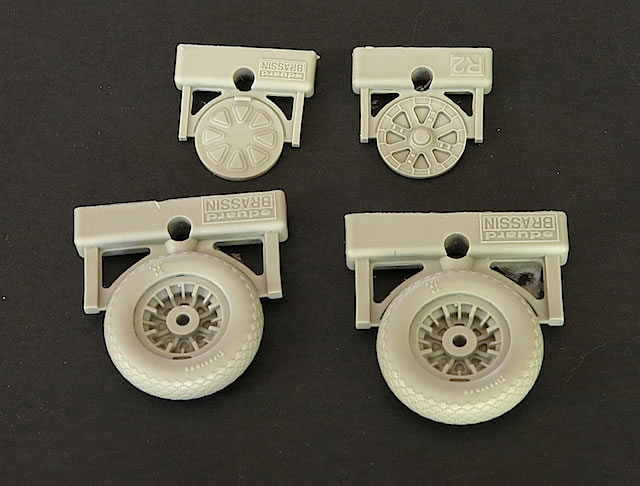
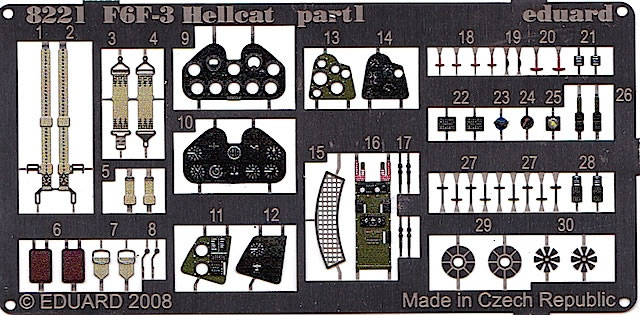
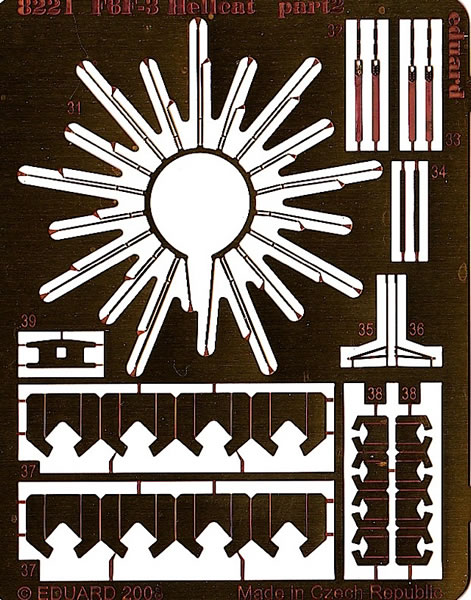
-
A 16-page A4 instruction booklet with full colour, four view painting and marking guides and a four view greyscale stencil placement guide, which also includes scrap drawings of the engine front and propeller blades.
-
One Eduard-produced decal sheet of all required markings, including stencils. These have been produced to a higher standard than some other Eduard sheets I have recently seen, with crisp printing, good registration and apparently solid colours (although the latter can’t be proven until the decal is on the model).
Markings
Markings are provided for the same five F6F-3s covered in the original two releases of this kit.
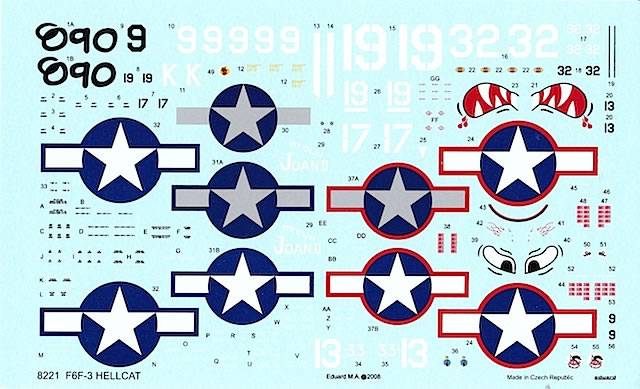
All are finished in variations of the USN’s mid-war tricolor scheme of Navy Blue over Intermediate Blue and White, and represent machines from across the spectrum of F6F-3 production.
- Probable BuNo.66016 of VF-16, USS Lexington, Hawaii, September 1943.
- BuNo.25813/‘My Own Joan II’ flown by Lt. C.K. ‘Ken’ Hilderbrandt of VF-33, based in New Georgia, Solomon Islands, December 1943.
- BuNo.40090, flown by Lt. William C. Moseley of VF-1, who was lost in combat in this machine over the Bonin Islands in June 1944.
- BuNo.40467, flown by Lt. Alexander Vraciu of VF-6, USS Intrepid, February 1944.
- BuNo. unknown, flown by Lt. Richard E. Stambook of VF-27, USS Princeton, October 1944. This aircraft’s snarling red-and-white mouth will make it the marking option of choice for many modellers.
Eduard’s 1/48 Hellcats have been deservedly popular over the years, and it’s good to see the kit that kicked things off back in production. The F6F is a chunky, imposing model in 1/48 and, for me at least, looks best in the tricolor camouflage featured in this boxing.
Highly recommended.
References
Bert Kinzey, ‘F6F Hellcat in Detail and Scale’ (Squadron/Signal Publications, 1996).
Thanks to Eduard for the sample and for the images.
Review Text Copyright © 2015 by Brad Fallen
Page Created 23 January, 2015
Last updated
23 January, 2015
Back to HyperScale Main Page
Back to Reviews Page

|
